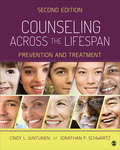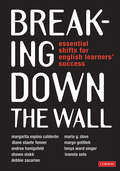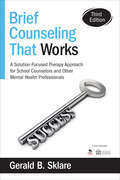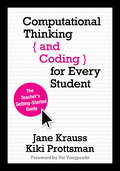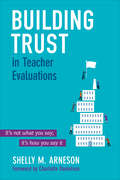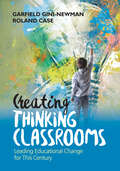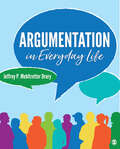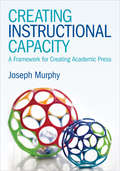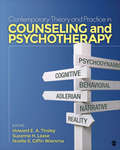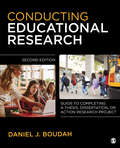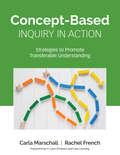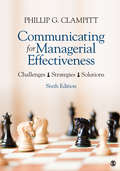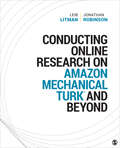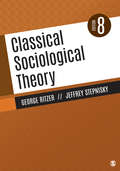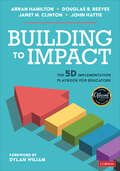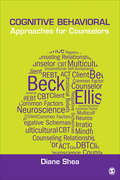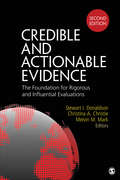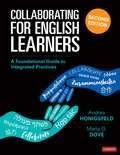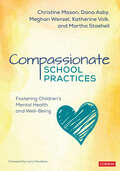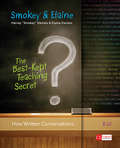- Table View
- List View
Counseling Across the Lifespan: Prevention and Treatment
by Jonathan P. Schwartz Cindy L JuntunenThis practical book helps readers provide effective mental, emotional, and behavioral health services to clients across the continuum of care, from health promotion through long-term treatment and remediation. Anchoring each chapter within a life stage—from childhood through older adulthood—the text identifies the nature and origin of various psychological issues and emphasizes the importance of anticipating and responding early to concerns that arise for large portions of the population. The Second Edition features new chapters and expanded coverage of important topics, such as sociocultural contextual factors and interprofessional health perspectives.
Breaking Down the Wall: Essential Shifts for English Learners’ Success
by Debbie Zacarian Maria G. Dove Margarita Espino Calderon Diane Staehr Fenner Tonya W. Singer Margo Gottlieb Ivannia Soto Shawn M. Sinclair-Slakk Andrea HonigsfeldIt was a dark and stormy night in Santa Barbara. January 19, 2017. The next day’s inauguration drumroll played on the evening news. Huddled around a table were nine Corwin authors and their publisher, who together have devoted their careers to equity in education. They couldn’t change the weather, they couldn’t heal a fractured country, but they did have the power to put their collective wisdom about EL education upon the page to ensure our multilingual learners reach their highest potential. Proudly, we introduce you now to the fruit of that effort: Breaking Down the Wall: Essential Shifts for English Learners’ Success. In this first-of-a-kind collaboration, teachers and leaders, whether in small towns or large urban centers, finally have both the research and the practical strategies to take those first steps toward excellence in educating our culturally and linguistically diverse children. It’s a book to be celebrated because it means we can throw away the dark glasses of deficit-based approaches and see children who come to school speaking a different home language for what they really are: learners with tremendous assets. The authors’ contributions are arranged in nine chapters that become nine tenets for teachers and administrators to use as calls to actions in their own efforts to realize our English learners’ potential: 1. From Deficit-Based to Asset-Based 2. From Compliance to Excellence 3. From Watering Down to Challenging 4. From Isolation to Collaboration 5. From Silence to Conversation 6. From Language to Language, Literacy, and Content 7. From Assessment of Learning to Assessment for and as Learning 8. From Monolingualism to Multilingualism 9. From Nobody Cares to Everyone/Every Community Cares Read this book; the chapters speak to one another, a melodic echo of expertise, classroom vignettes, and steps to take. To shift the status quo is neither fast nor easy, but there is a clear process, and it’s laid out here in Breaking Down the Wall. To distill it into a single line would go something like this: if we can assume mutual ownership, if we can connect instruction to all children’s personal, social, cultural, and linguistic identities, then all students will achieve.
Brief Counseling That Works: A Solution-Focused Therapy Approach for School Counselors and Other Mental Health Professionals
by Gerald B. SklareEverything you need for maximum counseling results in less time! Expert Gerald Sklare is back with a breakthrough approach to effective counseling. Get fresh insights and new applications for solution-focused brief counseling (SFBC). Revised and expanded chapters help you: • Conduct brief, short-term sessions that lead to rapid, observable change • Create well-defined client goals • Enable clients to envision and take steps toward a more hopeful future • Maximize your time for rapid, observable student progress • Use the solution-focused principles with reluctant clients • Conduct positive, goal-oriented parent conferences • Work with individuals in school and community settings You’ll find a brand new chapter on abbreviated SFBC sessions, updated case studies and research, helpful flow charts and note sheets, and invaluable practice exercises. This "how-to" book gives you everything you need to implement this powerful, innovative counseling approach. "Simple yet spectacular, my students and I LOVE Brief Counseling that Works! It presents a user-friendly, time-efficient, and very effective approach to counseling school-aged youth (and adults)!" —Bradley T. Erford, Professor Past President of the American Counseling Association Loyola University of Maryland
Computational Thinking and Coding for Every Student: The Teacher’s Getting-Started Guide
by Jane Krauss Kiki ProttsmanEmpower tomorrow’s tech innovators Our students are avid users and consumers of technology. Isn’t it time that they see themselves as the next technological innovators, too? Computational Thinking and Coding for Every Student is the beginner’s guide for K-12 educators who want to learn to integrate the basics of computer science into their curriculum. Readers will find Practical strategies for teaching computational thinking and the beginning steps to introduce coding at any grade level, across disciplines, and during out-of-school time Instruction-ready lessons and activities for every grade Specific guidance for designing a learning pathway for elementary, middle, or high school students Justification for making coding and computer science accessible to all A glossary with definitions of key computer science terms, a discussion guide with tips for making the most of the book, and companion website with videos, activities, and other resources Momentum for computer science education is growing as educators and parents realize how fundamental computing has become for the jobs of the future. This book is for educators who see all of their students as creative thinkers and active contributors to tomorrow’s innovations. "Kiki Prottsman and Jane Krauss have been at the forefront of the rising popularity of computer science and are experts in the issues that the field faces, such as equity and diversity. In this book, they’ve condensed years of research and practitioner experience into an easy to read narrative about what computer science is, why it is important, and how to teach it to a variety of audiences. Their ideas aren’t just good, they are research-based and have been in practice in thousands of classrooms…So to the hundreds and thousands of teachers who are considering, learning, or actively teaching computer science—this book is well worth your time." Pat Yongpradit Chief Academic Officer, Code.org
Building Trust in Teacher Evaluations: It’s not what you say; it’s how you say it
by Mary Shelly ArnesonYour breakthrough approach to top-notch teacher evaluations! This hands-on professional development guide explores the critical ingredients of communication and trust for success in the new age of teacher evaluation systems. Recognized expert Shelly Arneson provides concrete, proactive strategies to help school leaders: Create and sustain a supportive, honest, and collaborative school culture Foster effective communication and build teacher-principal trust Conduct evidence-based observations and evaluations Hold effective follow-up conversations that nurture teacher growth Promote teacher self-assessment and reflection Includes absorbing real world vignettes, reflection questions, and ample modeling examples for quick success. Before heading into an observation or post-observation conference you’ll find quick nuggets of wisdom you can reference again and again. Use this informative guide to transform the teacher evaluation process today! " An absolute essential for any bookshelf of the novice or seasoned administrator. . . . Really hits home on how trust is essential for effective evaluations. . . . The book covers all angles of why trust and evaluations go hand in hand." —Jason Eitner, Superintendent The Lower Alloways Creek School District, Canton Salem, NJ "In order for student growth to make a positive impact you, as the instructional leader, need to make a positive impact with your teachers; this starts with trust and building a better teacher via evaluations. This book will lead you in that direction!" —Elizabeth Alvarez, Principal John C. Dore Elementary School, Chicago, IL
Creating Thinking Classrooms: Leading Educational Change for This Century
by Garfield Gini-Newman Roland CaseReinvigorating today’s schools with Critical, Creative and Collaborative thinking Critical, creative and collaborative thinking should be at the centre of all 21st century teaching and learning. Creating Thinking Classrooms is loaded with examples, stories and strategies for reinvigorating schools with this quality thinking. Written for leaders who support teachers, this guide treats educational change as a process of renovation, rather than process of revolution, and emphasizes building upon, refining and sustaining the many good things happening in today’s schools. Practical and user-friendly, it emphasizes five key principles for learning and teaching: Engaging students Sustaining inquiry Nurturing self-regulated learners Creating assessment-rich learning Enhancing learning through digital technology As a balanced and reasoned response to the challenges and opportunities facing schools, this book separates the rhetoric of school reform from reality by analyzing what’s actually happening and offering a plan educators can use. Recapture the fundamentals of classroom learning with a practical and powerful roadmap charting the way forward. As a principal and community superintendent, I observed firsthand how transformational the work of Garfield Gini-Newman and Roland Case is in the school community, and on a systemic level, in the school community, and on a systemic level. Creating Thinking Classrooms takes theory and research and places it directly into the hands of practitioners by offering thoughtful and immediately-useful strategies. Not only does this work transform engagement and achievement, but it also transforms thinking for both teachers and their students. Teaching and learning go from passive acquisition of information to active, purposeful, and deliberate interaction with the curriculum. It is a must-read! Ursula A. Hermann, Ph.D, retired principal and community superintendent Montgomery County Public Schools What impresses me most about Creating Thinking Classrooms is the notion of framing the retooling of schools as renovation or reinvigoration rather than as revolution. Too many seem to ignore that there are many good things worth preserving in our schools and others that need to be reframed or recast to give them greater currency. This book builds on what has worked and makes it better. The message – being purposeful and patiently focused on long-term success – is a powerful one that needs to be heard above the din. David Chojnacki, Executive Director Near East South Asia Council of Overseas Schools
Argumentation in Everyday Life
by Jeffrey P. Drury"Good coverage of concepts with understandable explanations of theory. Very user friendly with exercises to use in and out of class. Connects well with other communication classes through the application of other communication concepts to argumentation." —Christopher Leland, Azusa Pacific University Argumentation in Everyday Life provides students with the tools they need to argue effectively in the classroom and beyond. Jeffrey P. Mehltretter Drury offers rich coverage of theory while balancing everyday applicability, allowing students to use their skills soundly. Drury introduces the fundamentals of constructing and refuting arguments using the Toulmin model and ARG conditions (Acceptability, Relevance, and Grounds). Numerous real-world examples are connected to the theories of rhetoric and argumentation discussed—enabling students to practice and apply the content in personal, civic, and professional contexts, as well as traditional academic debates. Encouraging self-reflection, this book empowers students to find their voice and create positive change through argumentation in everyday life. Unique resources to help students navigate this complex terrain of argumentation: "The Debate Situation" offers students a birds-eye view of any given debate (or exchange of arguments between two or more people) organized around three necessary components: arguments, issues, and the proposition. The visual model of the debate situation illustrates how these features work together in guiding a debate and it lays the groundwork for understanding and generating arguments. Easy to Use Standards for Evaluating Arguments combine a prominent argument model (named after logician Stephen Toulmin) with a standards-based approach (the ARG conditions) to test of quality of an argument. The ARG conditions are three questions an advocate should ask of an argument in determining whether or not it is rationally persuasive. These questions are best served by research but don’t necessary require it, and thus they provide a useful posture for critically assessing the arguments you encounter. Multiple "Everyday Life" examples with an emphasis on context help students to connect the lessons more fully to their everyday life and encourages them to grapple explicitly with dilemmas arising in different contexts. "Find Your Voice Prompts" focus on choice & empowerment to offer strategies for students to choose which arguments to address and how to address them—empowering students to use argumentation to find their voice. "Build Your Skill Prompts" use objective applications to test how well students have learned the information. They offer a chance to apply the material to additional examples that students can check against the answers in Appendix II. Two application exercises at the end of each chapter encourage students to think critically about the content, discuss their thoughts with their peers, and apply the material to everyday situations.
Creating Instructional Capacity: A Framework for Creating Academic Press
by Joseph F. MurphyGreat leaders create stronger foundations by building Instructional Capacity Technology and the age of information have forced educators to rethink how they can create a supportive culture and build academic press. School leaders who learn how to balance these ideas will build successful teams to meet today’s standards. In this companion to Creating Productive Cultures in Schools, Joe Murphy unpacks essential elements of building instructional capacity-Academic Press- through effective management of instruction, curriculum, and assessment. Leaders and change facilitators who read this will: Be reminded how effective instruction works and what forces shape it Understand how powerful assessment ideas can guide successful change Discover secrets to hiring and developing capacity-rich talent Know how to approach and manage curriculum for 21st century outcomes "Over the past decade increasing emphasis has been given by scholars, policymakers and practitioners to the role leaders play in building the capacity of schools to improve teaching and learning. This volume provides a sound foundation for thinking about the meaning of ′capacity′ as well as the tools leaders can use for productive impact." Dr. Philip Hallinger Professor of Educational Management, Chulalongkorn University (Thailand) "This book is a practical synthesis of what we know about fostering instructional improvement that should be a required read for every principal. Murphy goes to the heart of leadership by focusing on what can be done in any school or community to strengthen teachers’ capacity to serve all students. There are no simple checklists, but a wise distillation of core ideas that will work in complex settings." Karen Seashore Louis, Regents Professor University of Minnesota
Contemporary Theory and Practice in Counseling and Psychotherapy: Tinsley: Contemporary Theory And Practice In Counseling And Psychotherapy + Theories Of Counseling And Psychotherapy In Action
by Noelle S. Giffin Wiersma Howard E. A. Tinsley Suzanne H. LeaseThis comprehensive, topically arranged text provides a contemporary account of counseling theories as practiced by internationally acclaimed experts in the field. Each chapter covers the way mindfulness, strengths-based positive psychology, and the common factors model is integrated into the theory. A special emphasis on evidence-based practice helps readers prepare for their work in the field. Key Features The text focuses on how each theory presents a useful and effective basis for contemporary practice, providing students with the most up-to-date scholarship on current theories and how these theories guide the practice of today’s counselors and psychotherapists. Chapters are written by internationally acclaimed experts offering a truly global and complete perspective of the field. Discussion of the pros and cons of each theoretical approach allows students to explore all sides of an approach, offering an opportunity for balanced, critical analysis of the material. Brief therapies or "manualized" approaches, developed in response to the limits imposed by insurance companies on the number of reimbursable therapy sessions per client, are addressed, as many theoretical approaches offer strategies for providing these therapies. Careful discussion in every chapter of the applicability of theories to a diverse client population allows readers to address the specific needs of a broader clientele while acknowledging gender, race, age, sexual orientation, religion, etc. Integrated coverage of and a separate chapter on evidence-based practice introduce students to what is becoming the expected standard for effectively working with clients. Lists of additional resources from expert contributors allow students to further explore the concepts presented.
Contemporary Theory and Practice in Counseling and Psychotherapy: Tinsley: Contemporary Theory And Practice In Counseling And Psychotherapy + Theories Of Counseling And Psychotherapy In Action
by Noelle S. Giffin Wiersma Howard E. A. Tinsley Suzanne H. LeaseThis comprehensive, topically arranged text provides a contemporary account of counseling theories as practiced by internationally acclaimed experts in the field. Each chapter covers the way mindfulness, strengths-based positive psychology, and the common factors model is integrated into the theory. A special emphasis on evidence-based practice helps readers prepare for their work in the field. Key Features The text focuses on how each theory presents a useful and effective basis for contemporary practice, providing students with the most up-to-date scholarship on current theories and how these theories guide the practice of today’s counselors and psychotherapists. Chapters are written by internationally acclaimed experts offering a truly global and complete perspective of the field. Discussion of the pros and cons of each theoretical approach allows students to explore all sides of an approach, offering an opportunity for balanced, critical analysis of the material. Brief therapies or "manualized" approaches, developed in response to the limits imposed by insurance companies on the number of reimbursable therapy sessions per client, are addressed, as many theoretical approaches offer strategies for providing these therapies. Careful discussion in every chapter of the applicability of theories to a diverse client population allows readers to address the specific needs of a broader clientele while acknowledging gender, race, age, sexual orientation, religion, etc. Integrated coverage of and a separate chapter on evidence-based practice introduce students to what is becoming the expected standard for effectively working with clients. Lists of additional resources from expert contributors allow students to further explore the concepts presented.
Conducting Educational Research: "Guide to Completing a Thesis, Dissertation, or Action Research Project"
by Daniel Joseph BoudahDesigned to be used during the research process, Conducting Educational Research: Guide to Completing a Thesis, Dissertation, or Action Research Project, Second Edition walks readers through each step of a research project or thesis, including developing a research question, performing a literature search, developing a research plan, collecting and analyzing data, drawing conclusions, and sharing the conclusions with others. Throughout the book, Daniel J. Boudah covers all types of research (including experimental, descriptive, qualitative, group designs, and single subject designs) and helps readers link research questions to designs, designs to data sources and data sources to appropriate analyses. Each chapter includes activities and exercises to ensure the researcher is asking the right questions and producing a quality project.
Concept-Based Inquiry in Action: Strategies to Promote Transferable Understanding (Corwin Teaching Essentials)
by Rachel French Carla Marschall"This is exactly what my school needs right now to support colleagues to build on the foundations of our written concept-based curriculum and to take-off our taught curriculum to the next - and highest - levels." Neville Kirton, Deputy Head of Secondary Colegio Anglo Colombiano, Bogota, Colombia "Filled with strategies, illustrations, diagrams, and pictures, this book really gives you the insight you need to help students better understand what they are learning. So many great ideas that can be used in any classroom. A must read for all educators." Amanda McKee, 9th, Algebra/Geometry, Secondary Certified Instructor/Mentor Johnsonville High School, Johnsonville, SC Create a thinking classroom that helps students move from the factual to the conceptual All students deserve the opportunity to think conceptually. But seeing conceptual relationships does not come naturally to every student. How can teachers construct thinking classrooms where students can move from the factual to the conceptual level of thinking? Concept-Based Inquiry in Action has the answers. In this book, the authors marry theory with practice to create a new framework for inquiry that promotes deep understanding: Concept-Based Inquiry. The key is helping students to inquire into concepts and the relationships between them using guiding questions developed by the teacher, the students themselves, or by the teacher and students together. Step by step, the authors lead both new and experienced educators to implement teaching strategies that support the realization of inquiry-based learning for understanding in any K–12 classroom. The book and its accompanying website are rich with the resources necessary to facilitate the construction and transfer of conceptual understanding, including Numerous practical teaching strategies, aligned to each phase of Concept-Based Inquiry, that can be modified for diverse populations Visual notes that represent significant ideas discussed within each chapter Videos of instructional strategies and teacher interviews that show Concept-Based Inquiry in action in K–12 classrooms around the world Templates of graphic organizers, sample anchor charts, and blackline masters that support the use of teaching strategies in the classroom Planners that show how the phases of Concept-Based Inquiry come together in a unit In a world filled with complexity, the role of the teacher as a facilitator of conceptual understanding has never been more pressing. Concept-Based Inquiry in Action provides teachers with the tools necessary to organize and focus student learning around concepts and conceptual relationships that support deep understanding.
Communicating for Managerial Effectiveness: Challenges | Strategies | Solutions
by Phillip G. ClampittAppreciated by thousands of thoughtful students, successful managers, and aspiring senior leaders around the world Communicating for Managerial Effectiveness skillfully integrates theory, research, and real-world case studies into models designed to guide thoughtful responses to complex communication issues. The highly anticipated Sixth Edition builds on the strategic principles and related tactics highlighted in previous editions to show readers how to add value to their organizations by communicating more effectively. Author Phillip G. Clampitt (Blair Endowed Chair of Communication at the University of Wisconsin–Green Bay) addresses common communication problems experienced in organizations, including: Communicating about major changes spanning organizational boundaries Selecting the proper communication technologies Transforming data into knowledge Addressing ethical dilemmas Providing useful performance feedback Structuring and using robust decision-making practices Cultivating the innovative spirit Building a world-class communication system
Careers in Criminal Justice: Hanser, Introduction To Corrections 2e + Johnston, Careers In Criminal Justice
by Coy H. JohnstonCareers in Criminal Justice, Second Edition prepares students to plan, pursue, and realize their career goals—from conception through the hiring process. Coy H. Johnston’s contemporary approach emphasizes student self-reflection and pragmatism in the pursuit of self-fulfillment and professionalism. With coverage of over forty careers in policing, courts, corrections, and victim services, students receive a comprehensive overview of the most popular and growing careers in the field. Self-assessment tools enhance the student’s self-awareness and steer them toward realistic and suitable careers in criminal justice. This easy-to-read guide is organized to prepare and encourage growth throughout the student’s career. New to the Second Edition: A new chapter titled "Volunteering and Internship" (Chapter 9) guides readers through the importance and process of early involvement in the field to create a more enticing resume. Three new "Guest Speaker" profiles offer students new perspectives and practical advice for a variety of careers and geographical areas. New career assessment tools are included to help students realize their compatibility with various careers in the criminal justice field. Expanded coverage of information in critical areas such as private prisons, careers in the judiciary, and resume building ensure students are receiving a balanced introduction to criminal justice careers.
Conducting Online Research on Amazon Mechanical Turk and Beyond (SAGE Innovations in Research Methods #1)
by Jonathan Robinson Leib LitmanConducting Online Research on Amazon Mechanical Turk® and Beyond, written by Leib Litman and Jonathan Robinson, provides both students and experienced researchers with essential information about the online platforms most often used for social science research. This insightful and accessible text answers common questions like, "How do I maintain data quality in online studies?," "What is the best way to recruit hard-to-reach samples?" and "How can researchers navigate the ethical issues that are unique to online research?" Drawing on their experiences as the founders of CloudResearch (formerly TurkPrime), the authors provide information that guides new users planning their first online studies and engages even the most experienced researchers with detailed discussions about the challenges of online research. The book begins with an overview of Amazon’s Mechanical Turk and its rapid rise within academic research. Then, the authors describe how to set up an MTurk study with screenshots that walk readers through the steps of creating an account, designing a study, collecting data, and using third-party applications to enhance MTurk’s functionality. Later chapters provide readers with a detailed understanding of the MTurk environment and use data from hundreds of thousands of participants and tens of millions of completed tasks to dive into issues like participant demographics, sources of sampling bias, and the generalizability of findings from MTurk. Finally, the book explores the benefits of using other online platforms as a complement to MTurk and the ethical issues that are unique to conducting research with online participant platforms. Throughout the book, the authors share hands-on advice and best practices, such as those for conducting longitudinal studies or carrying out complex studies. Altogether the mix of data, insight, and advice make this book an essential resource for researchers who want to understand the online environment and the most effective ways to conduct research online.
Classical Sociological Theory
by George Ritzer Jeffrey N. StepniskyThe authors are proud sponsors of the 2020 SAGE Keith Roberts Teaching Innovations Award—enabling graduate students and early career faculty to attend the annual ASA pre-conference teaching and learning workshop. Classical Sociological Theory, Eighth Edition, provides a comprehensive overview of the major theorists and schools of sociological thought from the Enlightenment roots of theory through the early 20th century. The integration of key theories with biographical sketches of theorists and the requisite historical and intellectual context helps students to better understand the original works of classical authors as well as to compare and contrast classical theories.
Building to Impact: The 5D Implementation Playbook for Educators
by Douglas B. Reeves John Hattie Arran Hamilton Janet May ClintonTurn ideas into goals—and goals into impact The road to school improvement and student achievement is paved with good intentions—so why does the destination seem so far away? If you’re like most educators, the answer is a pothole known as the implementation gap. This book provides a road map to bypassing that gap in your school or district, offering a carefully researched, field-tested methodology that takes leadership teams, professional learning communities, and educators all the way from good ideas to systematic impact. Following the five Ds, you’ll: Discover goals worth pursuing and problems worth addressing Design instruments and actions that generate deep impact Deliver interventions and collect data Double-back to monitor your progress and evaluate the impact Double-up to enhance, sustain, and scale your success You became an educator to make a difference in students’ lives. With this playbook, you’ll transform research and ideas into achievable actions—and make maximum impact.
Cognitive Behavioral Approaches for Counselors (Theories for Counselors)
by Diane SheaWritten from the common factors perspective, this scholarly yet engaging book introduces the historical development, process, evaluation, and application methods of Albert Ellis’ Rational Emotive Behavior Therapy (REBT) and Aaron Beck’s Cognitive Behavioral Therapy (CBT). To help counselors in training apply cognitive behavioral theories to practice, the book offers specific suggestions for how a culturally competent, contemporary proponent of REBT/CBT could integrate multicultural adaptations into his or her counseling practice, provides transcripts of actual client sessions, and presents a case study that uses REBT and CBT in treatment. Cognitive Behavioral Approaches for Counselors is part of the SAGE Theories for Counselors Series that includes Psychoanalytic Approaches for Counselors, by Frederick Redekop, and Person-Centered Approaches for Counselors, by Jeffrey H. D. Cornelius-White.
Credible and Actionable Evidence: The Foundation for Rigorous and Influential Evaluations
by Stewart I. Donaldson Melvin M. Mark Christina A. ChristieAddressing one of the most important and contentious issues challenging applied research and evaluation practice today—what constitutes credible and actionable evidence?—this volume offers a balanced and current context in which to analyze the long-debated quantitative-qualitative paradigms. In the Second Edition, the contributors, a veritable "who’s who" in evaluation, discuss the diversity and changing nature of credible and actionable evidence; offer authoritative guidance about using credible and actionable evidence; explain how to use it to provide rigorous and influential evaluations; and include lessons from their own applied research and evaluation to suggest ways to address the key issues and challenges. Reflecting the latest developments in the field and covering both experimental and non-experimental methods, the new edition includes revised and updated chapters, summaries of strengths and weaknesses across varied approaches, and contains diverse definitions of evidence. Also included are two new chapters on assessing credibility and synthesizing evidence for policy makers. This is a valuable resource for students and others interested in how to best study and evaluate programs, policies, organizations, and other initiatives designed to improve aspects of the human condition and societal well-being.
Crime Prevention: Programs, Policies, and Practices
by Steven E. Barkan Michael A. RocqueIn Crime Prevention: Programs, Policies, and Practices, criminologists Steven E. Barkan and Michael Rocque present a well-rounded exploration of evidence-based policies, programs, and practices. Grounded in criminological theory and emphasizing the social, psychological, and biological roots of crime, this text presents current research, perspectives, and examples that capture the key crime prevention concepts students should understand, including the public health model for crime prevention. Highlighting the importance of applying theory to real-world solutions, the authors′ discussion of crime prevention strategies integrates theory and practice throughout the text.
Collaborating for English Learners: A Foundational Guide to Integrated Practices
by Maria G. Dove Andrea HonigsfeldLooking for a silver bullet to accelerate EL achievement? There is none. But this, we promise: when EL specialists and general ed teachers pool their expertise, your ELs’ language development and content mastery will improve exponentially. Just ask the tens of thousands of Collaboration and Co-Teaching users and now, a new generation of educators, thanks to this all-new second edition: Collaborating for English Learners. Why this new edition? Because more than a decade of implementation has generated for Andrea Honigsfeld and Maria Dove new insight into what exemplary teacher collaboration looks like, which essential frameworks must be established, and how integrated approaches to ELD services benefit all stakeholders. Essentially a roadmap to the many different ways we can all work together, this second edition of Collaborating for English Learners features: All-new examples, case studies, illustrative video, and policy updates In-depth coverage of the full range of strategies and configurations for determining the best model to adopt Templates, planning guides, and other practical tools to put collaboration into practice Guidelines, self-assessments, and questionnaires for evaluating the strategies’ effectiveness By this time, the big benefits of teacher collaboration are well documented. Where teachers and schools struggle still is determining the best way to do so, especially when working with our ELs. That’s where Andrea Honigsfeld, Maria Dove, and their second edition of Collaborating for English Learners will prove absolutely indispensable. After all, there are no two better authorities.
Argumentation in Everyday Life
by Jeffrey P. Drury"Good coverage of concepts with understandable explanations of theory. Very user friendly with exercises to use in and out of class. Connects well with other communication classes through the application of other communication concepts to argumentation." —Christopher Leland, Azusa Pacific University Argumentation in Everyday Life provides students with the tools they need to argue effectively in the classroom and beyond. Jeffrey P. Mehltretter Drury offers rich coverage of theory while balancing everyday applicability, allowing students to use their skills soundly. Drury introduces the fundamentals of constructing and refuting arguments using the Toulmin model and ARG conditions (Acceptability, Relevance, and Grounds). Numerous real-world examples are connected to the theories of rhetoric and argumentation discussed—enabling students to practice and apply the content in personal, civic, and professional contexts, as well as traditional academic debates. Encouraging self-reflection, this book empowers students to find their voice and create positive change through argumentation in everyday life. Unique resources to help students navigate this complex terrain of argumentation: "The Debate Situation" offers students a birds-eye view of any given debate (or exchange of arguments between two or more people) organized around three necessary components: arguments, issues, and the proposition. The visual model of the debate situation illustrates how these features work together in guiding a debate and it lays the groundwork for understanding and generating arguments. Easy to Use Standards for Evaluating Arguments combine a prominent argument model (named after logician Stephen Toulmin) with a standards-based approach (the ARG conditions) to test of quality of an argument. The ARG conditions are three questions an advocate should ask of an argument in determining whether or not it is rationally persuasive. These questions are best served by research but don’t necessary require it, and thus they provide a useful posture for critically assessing the arguments you encounter. Multiple "Everyday Life" examples with an emphasis on context help students to connect the lessons more fully to their everyday life and encourages them to grapple explicitly with dilemmas arising in different contexts. "Find Your Voice Prompts" focus on choice & empowerment to offer strategies for students to choose which arguments to address and how to address them—empowering students to use argumentation to find their voice. "Build Your Skill Prompts" use objective applications to test how well students have learned the information. They offer a chance to apply the material to additional examples that students can check against the answers in Appendix II. Two application exercises at the end of each chapter encourage students to think critically about the content, discuss their thoughts with their peers, and apply the material to everyday situations.
Belonging and Inclusion in Identity Safe Schools: A Guide for Educational Leaders
by Amy Epstein Becki Cohn-Vargas Alexandrea Creer Kahn Kathe GogolewskiLead an identity safe learning community where students of all backgrounds thrive Students of all backgrounds reach their full potential when they feel a sense of belonging and inclusion. When their social identities are valued as assets rather than barriers to learning, they flourish. This guide provides evidence-based strategies that support you as a leader in creating an environment that promotes identity safe students, who experience a challenging curriculum that respects their diverse social identities. Features in the book include: Guiding principles for student voice, equalizing status and cultivating acceptance across race, ethnicity, gender and other differences Ideas and examples for anti-racist dialogue and activities for teachers and students that counter colorblind practices, stereotype threat and biases Vignettes, and examples of identity safe practices for students and adult learning for staff, families and the community Systems for student-centered assessment and data collection Resources for developing equitable school policies and a comprehensive identity safety plan for your school Educators fulfill the promise of an equitable education when students of all backgrounds know that who they are and what they think matters. Start the journey to become an identity safe school and see the results for yourself! “Belonging and Inclusion in Identity Safe Schools: A Guide for Educational Leaders is a timely and important book. For several years, the nation′s schools have been asked to focus their energies on raising student achievement. However, too often educators have ignored the need to honor, support and affirm the identities of the students they serve. For educators who serve children of color, particularly Black, Native American and Latinx children who are often subject to overt and covert forms of forced assimilation, this book will be an invaluable resource on how to create learning opportunities that make it possible for such children to thrive.” ~Pedro Noguera, Dean of Rossier School of Education, University of Southern California “Bravo to authors Cohn-Vargas, Gogolewski, Creer Kahn, and Epstein for their ground-breaking book on Identify Safe Schools for Administrators and Teacher and Staff Leaders! They provide much-needed evidence for educators to elevate and even inspire the equity, empowerment, and academic growth needed to wholly support all children to flourish in school and their lives.” ~Debbie Zacarian, Director, Zacarian and Associates
Compassionate School Practices: Fostering Children′s Mental Health and Well-Being
by Christine Y. Mason Dana Asby Meghan Wenzel Katherine T. Volk Martha StaeheliAlready Ready For What Will Come - SEL For A Culture Of Care Is your school prepared to care for all of the students, staff, and families in your community? Sadly, your school might be the only point of care for many. Be already ready--Establish a compassionate cultural foundation for strong relationships and holistic skills to weather stress, trauma, and promote well-being for your entire school population. Help your school or district use available resources to create a compassionate culture of justice and care for all by leaning into this book’s approach to leadership and social emotional learning. Discover a collaborative visioning process to elevate compassion through dialogue, policies, and protocol. Readers will find: Practical strategies for working with parents and communities Activities for the whole school An implementation framework for elementary, middle, and high school Deeper understanding of trauma, ACEs, and mental health concerns Support for teachers’ mental health What not to do – practices that don’t work, and why In-depth case studies and vignettes Read this and usher in transformational and compassionate change that may be the difference in whatever today, tomorrow, or the next day may bring.
The Best-Kept Teaching Secret: How Written Conversations Engage Kids, Activate Learning, Grow Fluent Writers . . . K-12 (Corwin Literacy)
by Elaine Daniels Smokey DanielsYour fast-track to student engagement Everywhere Smokey Daniels goes—every school he visits, every workshop he leads, every keynote he gives—there’s one teaching strategy that teachers embrace above all others. That single method for transforming students from passive spectators into active learners . . . for evoking curiosity, inspiring critical thinking, and building powerful writers along the way. Now, with Elaine Daniels as Smokey’s coauthor, that best-kept teaching secret is revealed to teachers at large: Written Conversations. Just what make Written Conversations so potent? An ongoing, thoughtful correspondence between students, and between students and their teachers, Written Conversations, above all else, catch and ride the wave of social interaction, which in turn makes school matter to kids. It’s that simple. Structure by structure, from beginning to end, Smokey and Elaine describe four variations of these "silent writing-to-learn discussions," during which all students in a classroom think and "talk" at once in writing, instead of one at a time out loud. How Written Conversations Work It all starts with mini-memos, short student letters that teachers use to introduce, extend, and assess class work. Then come dialogue journals, where pairs dive deeply into academic subjects. Next, groups of three or four students join in extended written discussions called write-arounds. Finally, kids take their thinking online, where they enjoy digital discussions with partners from their own classroom—and with kids from around the world. . . . all the while, you are supported by detailed descriptions of each structure, lessons, and annotated student samples—making this the most practical teaching book in recent memory. What kid wouldn’t want to refine written argument skills, clarify a point, or defend another’s viewpoint, when the "audience" is people who matter? And Yes, Written Conversations align with the Common Core Standards for writing, reading, language, and speaking and listening, taking students well beyond the standards themselves.
